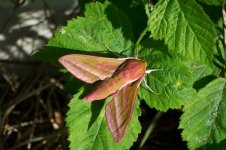jox said:
Hi from a newbie to this forum.
This afternoon i found what i eventually found out was an elephant hawk catapiller in my garden and i was hoping that my son and i could look after it and watch it change into the E-Hawk moth.Is this possible ? , if so how should a go about creating an enviorement that it will live in and eventually change into a moth in ?
Any ideas or suggestions would be helpful.
kind regards
JOX
Hello Jox,
If it is an Elephant Hawk moth larva you have, it will either have fed on Willowherb or Fuschia. Have a look around the area where you found it and see which of the two plants it is likely to have come from.
The larva may be nearly if not fully fed, as they seldom leave their foodplant until they are ready to pupate. When nearly ready they take on a slightly oily appearance and loose some of their bright coloration.
They are quite easy to rear provided you take a few precautions. Obtain a large plastic box, Tupperware will do, line it with a piece of kitchen paper towel and place two or three sprigs of foodplant in it with the larve. If you give it Fuschia change all the foodplant once a day, if you give it Willowherb change it twice a day, as it wilts very quickly. If the larva makes no attempt to feed then it is either :-
A. About to moult, in which case to not disturb it until the moult is complete and it is moving around again. Or
B. About to pupate.
If the latter, you will need to gather a good double handful of leaves. Willowherb leaves will do. Dry these off in an oven at a very low heat for half an hour or so. This should remove any moisture from them and also kill off any possible pests present.
Place the dead and dry leaves into the plastic box again lined with kitchen paper towel and introduce the larve. It may wander about for some time before starting to draw the leaves together to form a loose cocoon in which it will pupate. Once it has started to spin this cocoon cover the top with a piece of muslin or other fine meshed fabric and place it in a place that is cool all year round. That does not mean the shed or greenhouse, temperatures there fluctuate considerably. A shelf in an unheated garage is better. Then Dd not disturb it at all.
From late April, mist it lightly with water once a week, but do not soak it. This can be done through the fabric mesh covering the box. From early May examine it every day to see it the moth has emerged. With luck, one day you will have a nice fresh Elephant Hawk Moth. Moths bred in captivity tend to emerge slightly earlier than in the wild.
Any other queries, don't hesitate to ask.
Harry.





